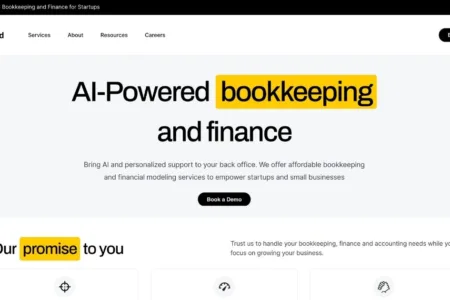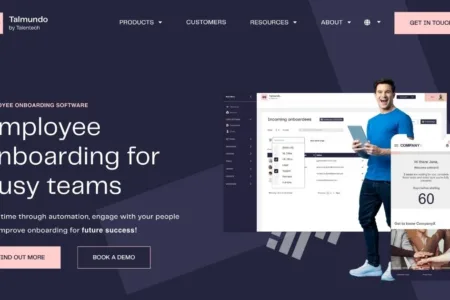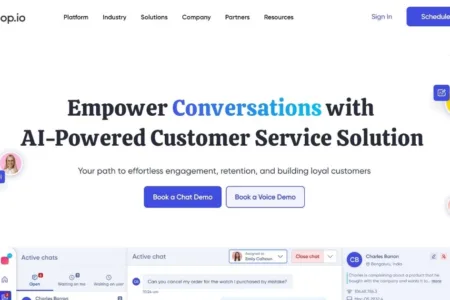[[{“value”:” Truewind is a cutting-edge business tool that offers AI-powered bookkeeping and financial services for startups and small businesses. With a focus on accuracy and efficiency, Truewind combines the power of AI technology with personalized support from their team of experts to deliver precise and transparent accounting solutions to their clients. One of the key features of Truewind is its unmatched accuracy in maintaining books every month. By leveraging AI technology and a dedicated concierge team, Truewind ensures that their clients receive accurate financial reports consistently, allowing them to make informed and timely business decisions. Truewind also prides itself on its ability to facilitate a faster monthly close process for their clients. While traditional bookkeeping processes can take weeks to complete, Truewind can close books in a matter of days, providing clients with up-to-date financial information to support their business operations. In addition to their commitment to accuracy and efficiency, Truewind offers world-class support to their clients. Their team of certified public accountants (CPAs) is available to assist clients every step of the way, ensuring that their best interests are always a top priority. With Truewind, entrepreneurs can have peace of mind knowing that their finances are in capable hands. Through a simple onboarding process, clients can take advantage of tailored finance solutions that allow them to focus on growing their businesses while Truewind handles the financial aspects. Overall, Truewind is a valuable tool for startups and small businesses looking to streamline their bookkeeping and financial operations. With a perfect combination of AI technology, personalized support, and efficient processes, Truewind empowers entrepreneurs to make smart financial decisions and drive the growth of their businesses. Truewind – Features Bookkeeping with AI technology and human expertise CFO Services for analyzing critical business drivers Taxes taken care of end-to-end Adaptation to current finance tech stack Financial Statements including Balance Sheet and Income Statement Financial Models for forecasting and analysis Variance analysis for budget vs actuals Financial Analysis for prompt answers to key questions. Truewind – Pricing Available upon request, free demo. Visit truewind.ai for more. Keep up to date with our stories on LinkedIn, Twitter , Facebook and Instagram. “}]]
[[{“value”:” Welcome to AI Weekly, where we delve into the cutting-edge and ever-evolving world of artificial intelligence and bring you concise yet comprehensive summaries of the most exciting AI developments. Workday to Acquire HiredScore Workday, a leading HR software provider, has entered into a definitive agreement to acquire HiredScore, a company specializing in AI-powered talent orchestration solutions. These solutions enable companies to leverage data-driven insights to enhance their recruiting and talent mobility processes. The integration of Workday Talent Management, Workday Skills Cloud, and HiredScore’s Talent Orchestration solutions will offer customers a comprehensive, transparent, and intelligent talent acquisition and internal mobility platform, enabling them to better address their evolving people needs. Google’s Initiative to Test Unreleased Gen AI Platform with Publishers Google has initiated a private program involving a select group of independent publishers, offering them beta access to an unreleased generative artificial intelligence platform in exchange for analytics and feedback. According to documents obtained by ADWEEK, participating publishers are expected to utilize the suite of tools to generate a specified volume of content over 12 months. In return, they receive a monthly stipend totaling a five-figure sum annually, along with access to content production resources tailored to their readership, all at no cost. Particle: An AI-Powered News Reader Developed by Former Twitter Engineers Particle.news, developed by a team led by former Twitter engineers, introduces a novel approach to using AI to assist people in processing news and information. This startup offers a personalized, multi-perspective news reading experience, leveraging AI not only to summarize news articles but also to ensure fair compensation for authors and publishers. Although Particle’s business model has yet to be disclosed, it arrives amidst growing concerns about the impact of AI on the news ecosystem, particularly regarding potential reductions in website traffic and advertising revenue for publishers. Apple Shifts Focus from Electric Car Project to AI Research Apple has terminated its electric car project, known as “Project Titan,” redirecting its research funding toward generative artificial intelligence endeavors. This decision reflects Apple’s strategy to diversify its focus beyond its flagship product, the iPhone, which still constitutes approximately half of its global sales. While the decade-long effort to develop a rival to Tesla and Rivian was never officially confirmed by Apple, news of the project’s cancellation was relayed to employees on Tuesday. Apple declined to comment on the matter. Google Introduces Genie: An AI Model for Generating 2D Platformer Games Google has unveiled Genie, a new generative artificial intelligence model capable of producing an infinite variety of 2D platformer video games. Marketed as an action-controllable world model, Genie was trained on unsupervised video game data and utilizes predictive analysis to generate game levels. Additionally, it can control playable characters and determine their movements. This development follows OpenAI’s recent introduction of Sora, a world model capable of generating hyperrealistic videos up to one minute in length. EU Investigates Microsoft’s Partnership with Mistral AI The European Union is scrutinizing Microsoft’s collaboration with French startup Mistral AI as part of its broader examination of the rapidly growing generative artificial intelligence sector, aiming to identify any potential competition concerns. In a brief statement released on Tuesday, February 27, the European Commission, the executive arm of the 27-nation bloc, announced its analysis of the agreement between the two companies, which was unveiled a day earlier. Microsoft refrained from commenting on the matter, while Mistral did not respond to requests for comment. Microsoft’s recent announcement revealed a €15 million investment in Mistral, a French company established less than a year ago. This partnership has the potential to reduce the US software giant’s dependence on OpenAI, the creator of ChatGPT, for the supply of the next generation of chatbots and other generative AI products. Keep up to date with our stories on LinkedIn, Twitter, Facebook and Instagram. “}]]
[[{“value”:” A recent GoDaddy study has revealed a thriving side hustle culture in Australia, with 61% of entrepreneurs running their side businesses alongside full-time jobs. Entrepreneurs who have transitioned their side hustle into a full-time venture are reaping substantial financial rewards, according to GoDaddy’s findings. A significant majority, 63%, report monthly turnovers of at least $5,000, with nearly a quarter (22%) generating over $25,000 monthly or $300,000 annually. Empowered by accessible online tools and services, these individuals are making significant returns on investment. Nearly a third (29%) started their ventures with as little as $500, and the majority (56%) dedicate fewer than 10 hours per week to their side hustles, yet more than half earn at least $500 per month to supplement their main income. Impressively, one in five (19%) are generating over $2,500 monthly, showcasing the lucrative potential of side hustles. It’s unsurprising that side hustlers are ambitious, with 83% aiming to grow their business revenues enough to transition to full-time entrepreneurship. GoDaddy found that entrepreneurs who have taken the leap and made their sidehustle business their main source of income are generating significant revenue. However, these impressive returns often come at the cost of hard work and sacrifice. Twenty-two percent of Australian entrepreneurs dedicate more than 40 hours per week to their businesses, and 47% experience high levels of stress. Despite these challenges, a resounding two-thirds (64%) express that life is better after making the leap to entrepreneurship. Microbusinesses: The engine of the economy Microbusinesses have emerged as a driving force in the Australian economy, particularly in the wake of the pandemic. GoDaddy’s Venture Forward data underscores their vital contribution, with a majority (52%) established after 2020 and 39% employing at least one other person. This contribution is poised to expand further, as 40% anticipate hiring additional personnel in the next twelve months. Despite subdued sentiments regarding the national economic outlook, Australian entrepreneurs remain optimistic about their own business prospects. While only a quarter (25%) express optimism about the national economy over the next six months, an impressive 71% are bullish about their own ventures. This reflects the confidence of Australian entrepreneurs, with a staggering 94% expressing confidence in their ability to successfully operate a business. Tamara Oppen, Vice President of English Markets at GoDaddy, commented: “GoDaddy’s Venture Forward data is unique in its ability to capture and analyse microbusinesses and demonstrates their enormous economic contribution to the Australian economy. Collectively, they have the power to add billions to the economy, while providing jobs, improving pay and increasing GDP in their local communities. “Microbusinesses are the engine of both their local and the Australian economy. We have very few studies that focus specifically on companies with under 10 employees. They are under-researched, misunderstood and often under-served. GoDaddy aims to change that, and we are determined to support and empower the everyday entrepreneurs by offering affordable and easy to use tools to help them grow..” Keep up to date with our stories on LinkedIn, Twitter, Facebook and Instagram. “}]]
[[{“value”:” Talmundo is a powerful employee onboarding software designed to make onboarding processes simple, effective, and enjoyable for both new hires and managers. By providing HR teams with the tools to create a baseline process, enrich the experience with personalized content, and empower managers to take an active role in the onboarding process, Talmundo aims to streamline the onboarding experience and ensure that new team members feel welcomed, supported, and engaged from day one. One of the key features of Talmundo is its ability to enable managers to contribute to the onboarding process seamlessly, eliminating the disconnect between HR and managers and reducing the risk of new hires slipping through the cracks. By providing managers with the necessary tools and guidance, Talmundo ensures that new hires receive the support they need to succeed in their new role. Through a balance of process and experience, Talmundo helps HR teams deliver a streamlined onboarding process that creates a sense of ease and confidence for new hires. By automating time-consuming tasks, engaging with employees through personalized content, and continuously improving the onboarding process for future success, Talmundo allows organizations to make first impressions count and set new hires up for a successful future. Overall, Talmundo offers a comprehensive solution for employee onboarding that not only saves time through automation but also improves engagement, ensures a smooth onboarding experience, and sets new hires up for success in their new roles. With Talmundo, HR teams can streamline their onboarding processes, empower managers to become onboarding ambassadors, and create a positive onboarding experience that fosters long-term success for both the organization and its employees. Talmundo – Features Smart automation to save time Interactive content for engaging employees Personalized onboarding experience Empower managers as onboarding ambassadors Intuitive reporting dashboards for insights Scalable personalization for employee engagement Improve new hire experience for future success Simplify and streamline employee onboarding process Talmundo – Pricing Available upon request, free demo. Visit talmundo.com for more. Keep up to date with our stories on LinkedIn, Twitter , Facebook and Instagram. “}]]
[[{“value”:” ABS data shows housing, food lead Australian inflation as prices rise 3.4% but AI and workforce development key to navigating inflationary waters, Charles Ferguson, General Manager at G-P says. “For businesses looking to do more with less when navigating churning waters, investing in artificial intelligence (AI) and workforce development can counter productivity declines and boost efficiency. Strategic use of the technology will allow employees to reduce the number of hours they spend working on manual tasks and allow them to focus on higher-value work instead. AI when leveraged effectively can complement and enhance employees’ capabilities rather than supplant their roles, and in doing so, add significant value to organisations during tough economic times while keeping costs low.” “The monthly CPI indicator rose 3.4% from January 2023 to January 2024, indicating that unsurprisingly, the cost of doing business will remain expensive this year. While there are glimmers of hope with the CPI indicator remaining steady from December 2023, offering a beacon of relief for business after two years of economic upheaval, the reality is that market conditions will remain tight for organisations of every scale in the foreseeable future. The Australian Bureau of Statistics (ABS) has released its monthly inflation indicator for January, showing a 3.4 percent increase over the preceding 12 months leading up to January 2024. Major contributors to this annual uptick include Housing (+4.6 percent), Food and non-alcoholic beverages (+4.4 percent), Alcohol and tobacco (+6.7 percent), and Insurance and financial services (+8.2 percent). However, this was partially offset by a decline in Recreation and culture (-1.7 percent), primarily attributed to reduced Holiday travel and accommodation prices (-7.1 percent). Breaking down specific categories, Housing saw a rise of 4.6 percent in the 12 months to January, with new dwelling prices climbing by 4.8 percent over the year. Rent prices experienced a significant uptick of 7.4 percent during the same period, reflecting a tight rental market nationwide. Annual electricity prices rose by 0.8 percent in the 12 months to January 2024. The introduction of the Energy Bill Relief Fund rebates for eligible households from July 2023 helped offset electricity price increases from annual price reviews in July. Excluding the Energy Bill Relief Fund rebates, electricity prices would have risen by 15.3 percent in the 12 months to January 2024, illustrating a substantial impact on household expenses. Anneke Thompson, Chief Economist, CreditorWatch said: “The monthly CPI remained steady in January at 3.4 per cent, although it showed a moderate decline when removing volatile items and holiday travel. Housing, particularly rents, continue to put pressure on the inflation rate, with rents rising 7.4 per cent over the year to January 2024, which was the same rate recorded in December. “Insurance and financial services cost inflation also remained high, and steady, at 8.2 per cent. There was a modest increase in food and non-alcoholic beverage inflation, caused mainly by an increase in the price of fruit and vegetables, which declined in price by 2.2 per cent over the year to December, but increased again by 1.6 per cent over the year to January. Given fruit and vegetable prices do jump around based on seasonal and weather factors, this should not give the RBA much cause for concern. “Overall, the rate remaining steady is positive news for borrowers. In particular, the RBA will be pleased to see some easing of inflation in the Health Services sector (from 4.7 per cent to 3.9 per cent), although other service sectors, such as education, have more ‘sticky’ inflation rates, with inflation in this category remaining steady at 4.7 per cent. The RBA, however, will need to see more significant easing in monthly inflation before it even begins to consider a cut to the cash rate.” Michelle Marquardt, ABS head of prices statistics, noted, “Annual inflation for the monthly CPI indicator was steady at 3.4%, marking the lowest annual inflation since November 2021.” She added, “When excluding volatile items from the monthly CPI indicator, the annual rise in January was 4.1%, down from 4.2% in December. Annual inflation excluding volatile items has been declining since the peak of 7.2% in December 2022.” Keep up to date with our stories on LinkedIn, Twitter, Facebook and Instagram. “}]]
[[{“value”:” Vrew is a cutting-edge video editing tool that simplifies the process of creating professional videos with its AI-powered features. With Vrew, video editing is as easy as text editing, thanks to its intuitive interface and powerful capabilities. One of Vrew’s standout features is its AI-powered subtitle generation, which allows users to easily add captions to long videos with minimal editing. Users can also provide a script to generate subtitles that perfectly match the video, saving time and effort in the editing process. With Vrew’s transcript-based editing, users can quickly find and edit specific points in their videos while reading through the transcript, eliminating the need to rewind and search for specific moments. The lightweight and easy-to-use interface of Vrew streamlines the video editing process, providing essential features without unnecessary fluff. Vrew also offers a one-stop shop for all royalty-free stock resources, including 100K stock images, thousands of stock videos, 200 background music tracks, 1000 sound effects, 100 fonts, and design text templates. This allows users to create professional videos without worrying about copyright concerns. Users can effortlessly create videos with AI voices using Vrew’s five languages and 200+ high-quality AI voices. By simply writing a script and adding stock resources, users can create their own videos with ease. Vrew also offers practical and jaw-dropping features such as the ability to create a video from a single sentence using AI, high-quality short-form video templates, a Silence Trimmer to eliminate silent sections, Manuscript Import for accurate subtitles, and the ability to create videos from PDF files with subtitles and voiceover. In addition, Vrew offers subtitle translation into over 100 languages, allowing users to display both the original and translated subtitles in their videos. Overall, Vrew is a versatile and powerful tool that makes video editing efficient and accessible for both beginners and professionals. Vrew – Features AI-powered subtitle generation Transcript-based editing 100K stock images, thousands of stock videos Effortlessly create videos with AI voices Create videos from text Short-form video templates Silence Trimmer Manuscript Import Vrew – Pricing Vrew offers Individual, Lite, Standard, and Business plans. Lite starts at $67/year, Standard at $124/year, and Business at $345/year. All plans include features like unlimited export, trim silence, and free assets. Advanced features are available in higher-tier plans. Visit voyagerx.com for more. Keep up to date with our stories on LinkedIn, Twitter , Facebook and Instagram. “}]]
[[{“value”:” Australian small and medium-sized enterprise (SME) manufacturers have witnessed a remarkable resurgence, with nine sectors reporting significant profitability gains, according to a recent report by inventory management software provider Unleashed. Despite a tumultuous year marked by fluctuating margins, Q4 marked a turning point, with Australian manufacturers recording an average profit of $2.22 for every dollar invested in inventory. For nine of the 13 sectors analysed, this quarter represented their most profitable period in two years. Steady sales in Q4 defied expectations, with 74% of surveyed manufacturers noting demand either met or exceeded projections. Jarrod Adam, Head of Product at Unleashed, attributed this positive trend to improving supply chain conditions throughout 2023. “Mapping lead time performance against stock levels shows the degree to which profitability has been positively affected by shorter – and more predictable – lead times in 2023,” Adam explained. The report revealed a significant improvement in lead times, dropping from an average of 31 days in Q1 to just 15 days by Q4. This reduction, coupled with decreased overstock levels, from an average of $276,000 in Q1 to $187,000 in Q4, contributed to enhanced profit margins. Adam noted, “The drop in lead times has allowed Australian firms to better maximize returns. Lower lead times in Q4 appear to have given manufacturers the confidence to shed some of their ‘Just in Case’ stock and shift towards more profitable ‘Just in Time’ strategies. Despite the overall positive outlook, concerns about high costs of goods and services persist, with 64% of manufacturers identifying it as the top business challenge. However, Adam remains optimistic about the future, stating that Q4 2023 positioned Australian manufacturers well for the year ahead. The report, based on gross margin return on inventory investment (GMROI) data across 16 manufacturing categories, highlights the resilience and adaptability of Australian SME manufacturers. Beverage Sector Leads the Charge Unlike the woe-begotten Beverage industry over the ditch in New Zealand, Australian beverage manufacturers ended the year with a strong $2.93 return on each dollar invested in inventory in Q4 2023. This is a huge resurgence from the relatively low $1.75 in Q4 2022. A combination of lower lead times of 12 days (3 days below the Australian average of 15) and strong customer demand for local beverage products has led to a vast uptick in profitability. Despite the positive signs for the broader beverage industry, brewer Dereck Hales of Bad Shepherd, said a multitude of issues continue to pressure smaller operators. Construction Sector Faces Challenges Despite Progress While Australian manufacturing in general is seeing healthy profits, Australian Building and Construction is in a tough spot. The Building and Construction industry faced continued revenue difficulties resulting in the relatively low profit margin of $1.32 (GMROI) in Q4 2023, almost a whole dollar below the Australian average of $2.22. This is the lowest profit margin for the construction industry since mid-2021 and is a measure of the issues facing the sector. Adding insult to injury are bloated overstock levels within the sector, with businesses on average holding $216,548 more than they needed in Q4 2023 – nearly $30,000 higher than the Australian average of $187,314. This is likely a reflection of a greater exposure to international supply chains in the construction industry, as well as a strongly held sense of risk around understocking, after the major supply chain issues seen during the pandemic. Despite remaining higher than average, Q4’s overstock levels still amount to progress for the Building and Construction industry, which has more than halved its levels within the calendar year, from $433,042 in Q1 2023, down to $216,548 in Q4 2023. The difficulties facing the industry have proven too much for several high profile construction companies, which have gone into liquidation this year, as manufacturers feel the bite of price pressure on materials. Auto Manufacturing Gears Up for Recovery After dipping into the red with a negative profit margin of $0.91 per dollar spent in 2021, the automotive manufacturing sector is now cruising towards a recovery in Q4 2023. Current profitability levels sit at a healthy $2.09, and its best news is to be seen in the non- profit numbers, and other business metrics such as overstock levels and lead day performance point to improving sector health.Automotive Manufacturing made significant gains towards getting overstock levels under control, now sitting at $159,960 in Q4 2023. This is far below the average Australian overstock rate of Q4 2022 which sat at $241,636. And it marks the first time this industry has dropped below the Australian average. Its average lead time is also a trim 12 days, three days below the Australian average of 15. Business metrics data of overstock and lead time point to Aussie auto manufacturing being in a good position going into 2024. Food Producers Navigate Challenges Amidst Rising Costs While beverage producers were one of the standout performers of Q4 2023, their counterpart food producers have been less successful. Food producers had an average profit of $1.87 per dollar spent on inventory, more than $0.30 cents below the Australian average of $2.22. But the main concern is the upward trend in overstock levels for food producers, now at an average of $222,370, up from $135,970 in Q12022. This trend puts increased pressure on businesses to move stock, and can create difficult decisions for businesses already in a tough spot. In positive news for food producers lead times are down to an average of 14 days, below the Australian average. Keep up to date with our stories on LinkedIn, Twitter, Facebook and Instagram. “}]]
[[{“value”:” Verloop is an innovative business tool that offers cutting-edge conversational AI solutions to help businesses effortlessly engage, retain, and build loyal customers. With Verloop, businesses can ignite customer experience magic by making conversations come alive and driving actionable outcomes unlike any other AI solution. One of the key features of Verloop is its use of Generative AI to deliver highly personalized and context-aware interactions that exceed customer expectations. This allows businesses to create conversational experiences that feel natural and engaging, helping to build strong relationships with customers. Verloop caters to a wide range of industries, including e-commerce, banking and financial services, travel, real estate, logistics, insurance, food services, and edtech. For e-commerce businesses, Verloop offers conversational sales experiences that can help drive conversions and increase customer satisfaction. In the banking and financial services sector, Verloop provides secure transactions, notifications, and KYC validation to ensure smooth and efficient interactions with customers. For businesses in the travel industry, Verloop enables the sharing of media-rich messages, notifications, and reminders to enhance the customer experience. Real estate companies can use Verloop to schedule site visits, share and verify documents, and provide personalized assistance to potential buyers. In the logistics industry, Verloop offers real-time updates and query troubleshooting to streamline operations and improve customer service. Insurance companies can benefit from Verloop’s ability to create conversational forms and KYC processes, making it easier for customers to provide necessary information and complete transactions. In the food services sector, Verloop helps manage orders, reservations, feedback, and queries to provide a seamless dining experience. Lastly, edtech companies can use Verloop to resolve problems in the preferred channel of communication for students, parents, and educators, improving overall satisfaction and engagement. Verloop – Features Chat automation for streamlining support Voice automation for personalized interactions AI-driven support to enhance problem resolution Empowering agents with intelligent tools Round-the-clock assistance for seamless operations Revolutionizing customer service with voice support automation Boosting efficiency and productivity for agents Enhancing excellence in customer service with AI-driven tools Verloop – Pricing Available upon request, free demo. Visit verloop.io for more. Keep up to date with our stories on LinkedIn, Twitter , Facebook and Instagram. “}]]
[[{“value”:” New data has exposed the glaring gender pay gap prevalent in some of Australia’s top corporations, including Commonwealth Bank, national carrier Qantas, and oil and gas explorer Woodside. The gender pay gap at these companies surpasses the national average of 19%. This revelation comes after the government mandated firms with over 100 employees to disclose the pay of male and female staff, in accordance with legislation passed in March 2023. Despite years of discourse from governments and corporations about narrowing the gender pay gap, the report underscores the significant disparity in earnings between men and women at major Australian employers. According to the Workplace Gender Equality Agency (WGEA), the median total remuneration gap for 2022/23 stands at 19% in favor of men. The difference in median base pay is 14.5%, while in average total pay, it reaches 21.7%. Alarmingly, only one-third of companies fall within the target range of a median gender pay gap between -5% and +5%. Minister for Women Katy Gallagher emphasized the urgent need for change, expressing concern over the prevalence of gender pay gaps in two-thirds of businesses. She stressed the importance of driving organizational change to ensure women receive fair opportunities and to gradually close the gender pay gap over time. Australia’s leading banks and energy firms, including Commonwealth Bank, AGL, and Woodside Energy, exhibit some of the widest gender pay disparities. For instance, Commonwealth Bank reported a median total remuneration gender pay gap of 29.9%, while AGL and Woodside Energy registered gaps of 33.2% and 30.2%, respectively. On the contrary, supermarket operator Woolworths, one of the country’s largest employers, boasts a narrower gap of just 5.7%. Holding Redlich has achieved an impressive gender pay gap of only 2.1%. The firm stands among the top 30% of Australian employers whose median gender pay gap falls within the target range of -5% to +5%. This is in stark contrast to the 62% of employers where the median gender pay gaps favour men by over 5%. Unsurprisingly 61% of Aussie women could quit Over half (61%) of Australian women would consider leaving their job if they find out that their organisation has a gender pay gap — regardless of how big the gap is — according to new research by HR tech unicorn HiBob. Surprisingly, 36% of men also express a willingness to leave, signalling a growing sense of solidarity and shared concern regarding pay disparities in the workplace. The finding comes just days before the Australian government’s Workplace Gender Equality Agency (WGEA) is due to start publishing the gender pay gaps of private-sector organisations with more than 100 employees on the 27th February 2024. The publication of gender pay gaps looks to be the final straw for many women in the workplace, with fewer women (36%) compared to men (55%) saying that organisations are doing enough to close the gap. A third of women (31%) go as far as to say that their organisation will never prioritise closing the pay gap. As for what would encourage women to consider a new job at a new company, pay has rocketed to the top of the list of reasons, with 78% saying they’d consider a new job for more money (up from 36% last year). Pay is then followed by a strong and healthy company culture (43%), then flexible work models (42%), and a clearer path to promotion (36%). These are the findings from HiBob’s third annual Women in the Workplace report, which surveys around a thousand men and a thousand women in Australia to uncover the many issues women face in the workplace. The research assesses pay, job progression, leadership, job security and more, at a time when the country faces economic uncertainty. Nirit Peled-Muntz, chief people officer at HiBob, said: “Pay is the foundation of the relationship between employees and employers — and if there’s a gap between genders, nothing damages that relationship more. “I don’t believe organisations deliberately set out to pay one gender more than another, but we do have a problem in Australia, and it’s something organisations need to prioritise fixing. Because not only is pay equality fair, it helps improve profitability. Research by McKinsey says that companies with the highest levels of gender and ethnic diversity are 15% and 35% more likely, respectively, to have financial returns above their industry’s average.” As for potential ways organisations could solve the gender pay gap, more than four in five (83%) women say that organisations should conduct annual pay equality audits, and a further four in five (84%) say that organisations should conduct performance and promotion audits annually to ensure they’re being done fairly. 84% of women also say organisations should promote and support diversity in leadership, and 79% say organisations should make diversity a core business value and foster an inclusive culture. Peled-Muntz continues: “Fixing the gender pay gap is the big ‘people challenge’ of our time, but an organisation can’t fix it if it doesn’t have the right employee remuneration data easily to hand. Getting that information is key to understanding why a gender pay gap exists within an organisation so you can take steps to rectify it.” The research also finds that pay is just the tip of the iceberg regarding the challenges facing Australian women in the workplace. 40% of women believe that men are promoted more often or quicker than women within their company, (compared with 18% of men who think this), indicating a huge disconnect in perceptions between genders. One in four women (26%) say that a colleague has made them feel uncomfortable or less qualified in the workplace based on their gender. Keep up to date with our stories on LinkedIn, Twitter, Facebook and Instagram. “}]]
[[{“value”:” New research from Roy Morgan reveals that more than 8 million Australians are currently at risk of mortgage stress as interest rate hikes take their toll. The study highlights a significant surge in mortgage stress in January following the Reserve Bank of Australia’s decision to raise rates in November, pushing the figure to a record high above 1.6 million. This escalation represents a substantial increase since May 2022 when the RBA initiated a cycle of interest rate hikes, resulting in 802,000 Australians facing potential mortgage stress. Currently, 1,609,000 mortgage holders, accounting for 31.0% of the market, are deemed ‘At Risk’ as their mortgage repayments exceed a certain proportion of household income. Additionally, 994,000 mortgage holders, or 19.8%, are classified as ‘Extremely At Risk’, indicating a precarious financial situation. The study underscores that unemployment is a key factor influencing income and mortgage stress. Despite recent improvements in household incomes due to a robust job market, rising interest rates since May 2022 have substantially increased the number of Australians vulnerable to mortgage stress. The escalating levels of mortgage stress among Australians could potentially have a significant impact on small and medium-sized enterprises (SMEs) across various sectors: Consumer Spending Reduction: As homeowners face higher mortgage repayments, they may cut back on discretionary spending, impacting SMEs in retail, hospitality, and leisure sectors. Decreased Business Investment: SMEs may hesitate to invest in expansion or innovation initiatives due to uncertainty surrounding consumer demand, affecting sectors such as technology, manufacturing, and professional services. Supply Chain Disruptions: Mortgage stress could lead to financial difficulties for some households, resulting in late payments or defaults on bills, causing disruptions in supply chains and affecting businesses reliant on timely deliveries. Increased Financial Strain: SMEs relying on consumer credit or loans may face challenges accessing financing if financial institutions tighten lending criteria, hindering business growth and investment opportunities. Employment Impact: As consumer spending declines and businesses face financial constraints, SMEs may implement cost-cutting measures such as reducing staff hours or laying off employees, contributing to higher unemployment rates. Michele Levine, CEO of Roy Morgan, highlights that mortgage stress increased in both December and January, reaching a new record high above 1.6 million mortgage holders considered ‘At Risk’. Despite easing inflation pressures, further interest rate increases could lead to new record highs in mortgage stress levels. “The latest figures for January 2024 represent an increase of 8,020,000 mortgage holders considered ‘At Risk’ since the RBA began raising interest rates in May 2022. The figures take into account 13 interest rate increases which raised interest rates by a total of 4.25% points to 4.35%. The extended pause in official interest rate increases for four months from July – October 2023 reduced the pressure on mortgage holders and allowed growth in several areas of the economy to ‘catch up’ and reduce mortgage stress from the mid-year highs above 1.56 million. However, the interest rate increase in November has added renewed pressure on mortgage holders. “The latest ABS monthly inflation figures for December 2023 showed a sharp decline in the indicator to 3.4% – down 0.9% points from a month earlier and down a large 5% points from a year earlier. This is the lowest annual inflation in Australia for over two years since November 2021 (3.2%). “Although inflation pressures are clearly easing, the level of inflation remains above the Reserve Bank’s preferred target range of 2-3% and in inflation indicators such as petrol prices remain high. For the first time in history average retail petrol prices have been above $1.80 per litre for a record 32 straight weeks – equivalent to eight months. For these reasons we have modelled a further interest rate increase of +0.25% in March 2024. If the RBA does raise interest rates by 0.25% in March, Roy Morgan forecasts mortgage stress would increase to 1.64 million mortgage holders (31.6%) considered ‘At Risk’ by April. This would represent a new record high number of mortgage holders considered ‘At Risk’ for mortgage stress. “The latest figures for January show that when considering the data on mortgage stress, it is always important to appreciate interest rates are only one of the variables that determines whether a mortgage holder is considered ‘At Risk’ of mortgage stress. The variable that has the largest impact on whether a borrower falls into the ‘At Risk’ category is related to household income – which is directly related to employment. The employment market in Australia has been exceptionally strong over the last year and this has underpinned rising household incomes which have played a part in reducing overall mortgage stress in January. However, rising interest rates since May 2022 have caused a large increase in the number of mortgage holders ‘At Risk’. If there is a reacceleration in inflation over the months ahead, that results in further interest rate increases in 2024, levels of mortgage stress are set to increase further to new record highs.” To learn more about Roy Morgan’s mortgage data, call (+61) (3) 9224 5309 or email askroymorgan@roymorgan.com. Keep up to date with our stories on LinkedIn, Twitter, Facebook and Instagram. “}]]










